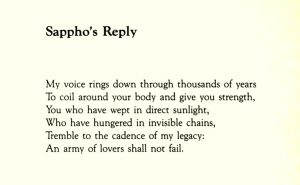
In this poem, Rita Mae Brown embodies her imagined perception of Sappho, addressing lesbians of her time. Speaking to them “through thousands of years,” she offers words of encouragement and survival. She, as Sappho, has witnessed and understood their suffering, and yet consoles them that “an army of lovers shall not fail.”
“Sappho’s Reply” was first published in Brown’s 1971 poetry collection The Hand That Cradles the Rock. By using this title to refute the maternal cliche (“the hand that rocks the cradle”) and turn it into an image of power and resilience, Brown sets the tone for her entire collection.
Brown was an integral figure to the Feminist Poetry Movement of the ‘70s, serving as a contributor and editor for several prominent periodicals and journals including Sinister Wisdom, Lesbian Connection, Amazon Quarterly, and The Furies. She was a leader of the Redstockings, a consciousness-raising radical feminist group, yet eventually left the group due to the lack of support of lesbian issues. Similarly, she left her position with the National Organization for Women after its attempts to distance itself from and ignore lesbian feminist groups.
Speaking on her time with these organizations, Brown stated that she “felt like the only lesbian” in America at times in the 1970s. “Yeah, I don’t recommend it,” she reflected in a 2015 Washington Post article (Burns). Yet Brown had a fulfilling career fighting for lesbian rights through poetry and politics. After leaving the Redstockings, she was a prominent figure in the Lavender Menace, a group of lesbian radical feminists that formed in 1970 in response to the exclusion of lesbians from many feminist issues. She also served as a founding member of The Furies Collective, a lesbian commune that treated heterosexuality as a barrier to revolution (Burns).
Brown’s struggles as a lesbian woman within the feminist movement give a deeper meaning to her interpretation of Sappho. “You who have wept in direct sunlight / Who have hungered in invisible chains” could speak to Brown’s own fight and the isolation she felt due to her sexuality. The poem’s final line, “An army of lovers shall not fail,” was adopted by gay and lesbian activists throughout the 70s and beyond—and even featured on the cover of the periodical The Lesbian Tide (Faderman 232). The “army of lovers” imagery could very well have its roots in Plato’s writing, specifically his Symposium, where the character Phaedrus employs that exact phrase to refer to the Sacred Band of Thebes, a group made up of pairs of male lovers that fought as part of the Theban army. Describing the queer people of the 1970s as “an army” is immensely powerful, especially after following the descriptions of their pain and suffering that make up the body of the poem. It emphasizes their strength and the unity that exists between them, and using Plato’s phrase harkens back to the powerful army made up of queer people in ancient history.
Works Cited:
Burns, Carole. “Rita Mae Brown, Awarded as Pioneer of Lesbian Literature, Scoffs at the Term.” The Washington Post, WP Company, 30 May 2015, https://www.washingtonpost.com/entertainment/books/rita-mae-brown-awarded-as-pioneer-of-lesbian-literature-scoffs-at-the-term/2015/05/30/60169a62-00a5-11e5-833c-a2de05b6b2a4_story.html.
Faderman, Lillian. The Gay Revolution: The Story of The Struggle. Simon & Schuster Paperbacks, 2016, p. 232.
Moore, Honor, and Rita Mae Brown. “Sappho’s Reply.” Poems from the Women’s Movement. Library of America, New York, 2009, p. 41.
